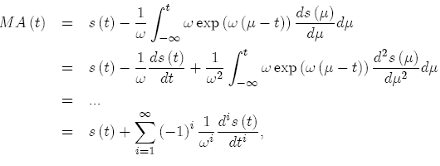Proof of Proposition 1
Substitute eqs. (3)-(4) and eq. (10) into eq. (12), and differentiate the resulting equation with respect to s, m and MA keeping p constant and noting that dm = ds = dp
 (A1)
(A1)
Since
 (A2)
(A2)
eq. (A.1) can be solved for ds/dm, and the proof is completed.
Proof of Proposition 2
By using integration by parts repeatedly,
 (A3)
(A3)
and the proof is completed.
Proof of Proposition 3
The dynamic system consisting of eqs. (1)-(5), eq. (9) and eq. (19) (assuming equality in the equation) can be written as a system of four first-order differential equations:
 (A4)
(A4)
where we also have utilized eqs. (10)-(11). The Jacobian matrix evaluated at equilibrium i.e. dp/dt = ds/dt = du/dt = dv/dt = 0, is then
 (A5)
(A5)
The dynamic system has four roots, which are denoted by λ0, λ1, λ2 and λ3. Then,
 (A6)
(A6)
which means that zero, two or four roots has a negative real part. However, the case of four roots with a negative real part can be ruled out since the Routh-Hurwitz conditions are not fulfilled (Coppel, 1965, p. 158). Specifically, the Routh-Hurwitz conditions state that the necessary and sufficient conditions for a real polynomial of degree four,
 (A7)
(A7)
to have four roots with a negative real part are that
 (A8)
(A8)
In this particular case, the characteristic equation, det (J - λl) = 0, is
 (A9)
(A9)
For example, a2 = -αβω  0. Then, let Xa,b,c be the 3 x 3 principal minor of J associated with the rows
and columns a, b and c. Then, according to Theorem 1.2.12 in Horn and Johnson (1985, p. 42),
0. Then, let Xa,b,c be the 3 x 3 principal minor of J associated with the rows
and columns a, b and c. Then, according to Theorem 1.2.12 in Horn and Johnson (1985, p. 42),
 (A10)
(A10)
which rules out the case of zero roots with a negative real part. Therefore, two of the four roots have a negative real part, which means that the model is characterized by saddle-path stability and the proof is completed.
By Mikael Bask
Next: Books: Currency Market
Summary: Index